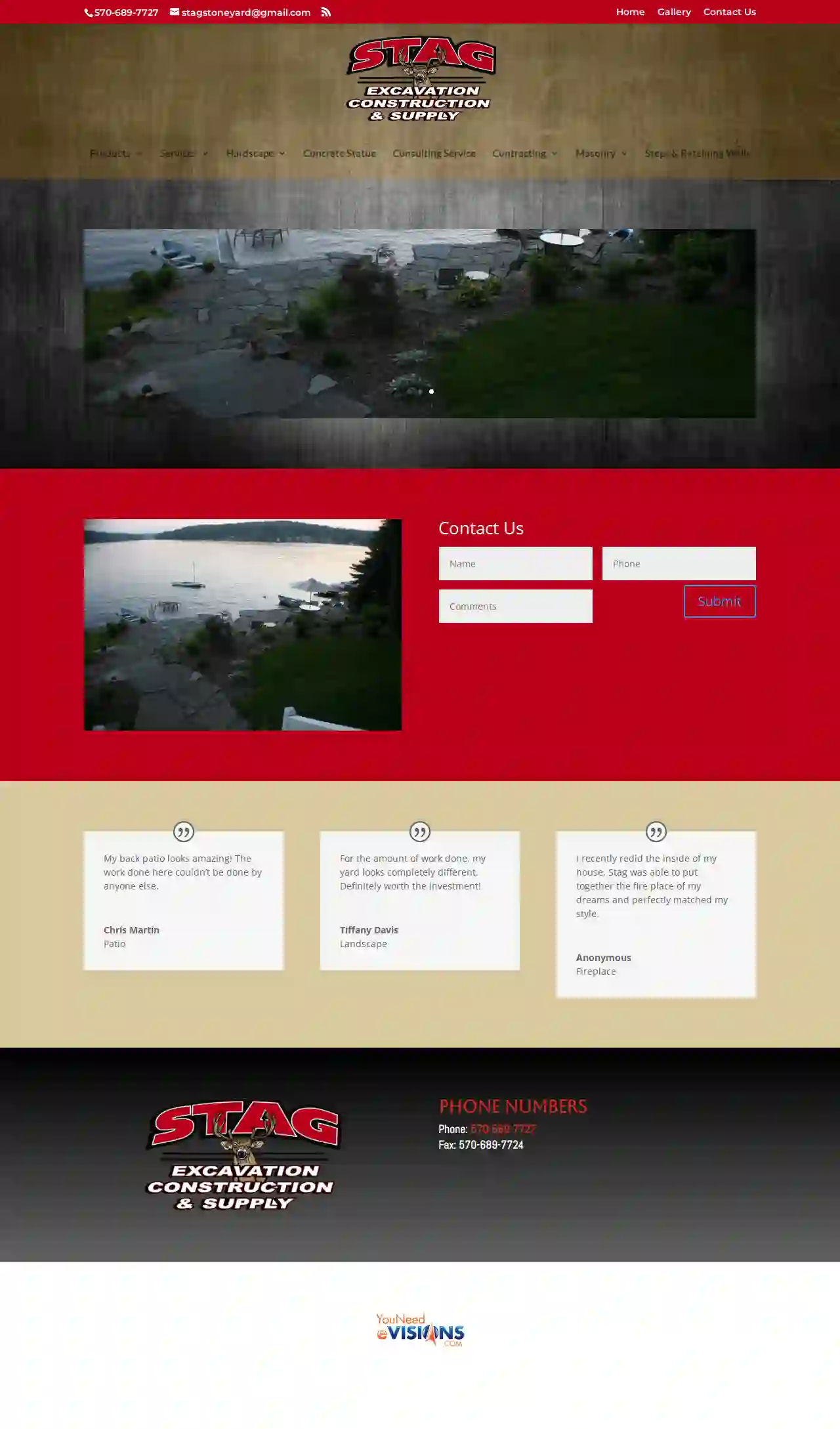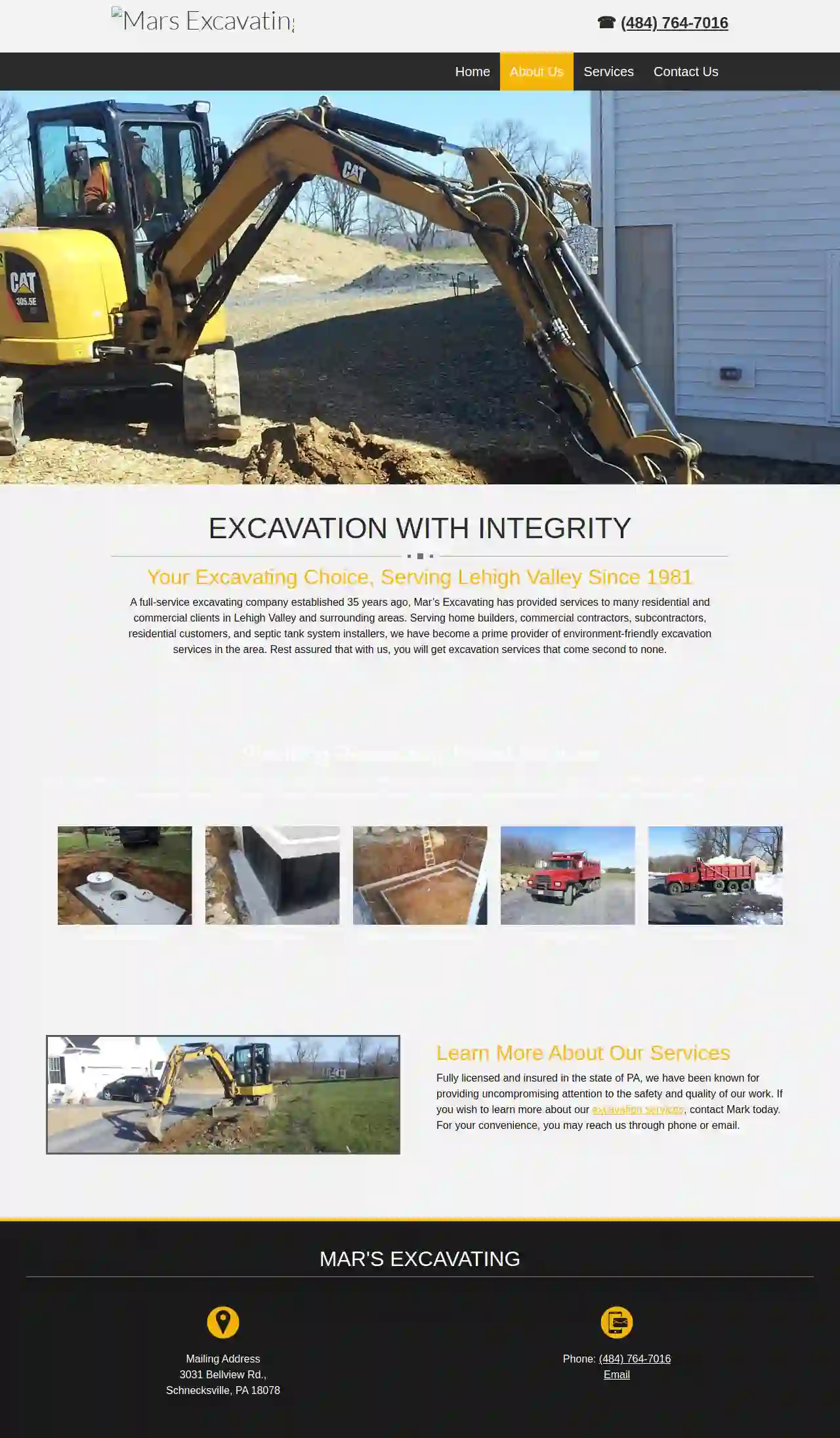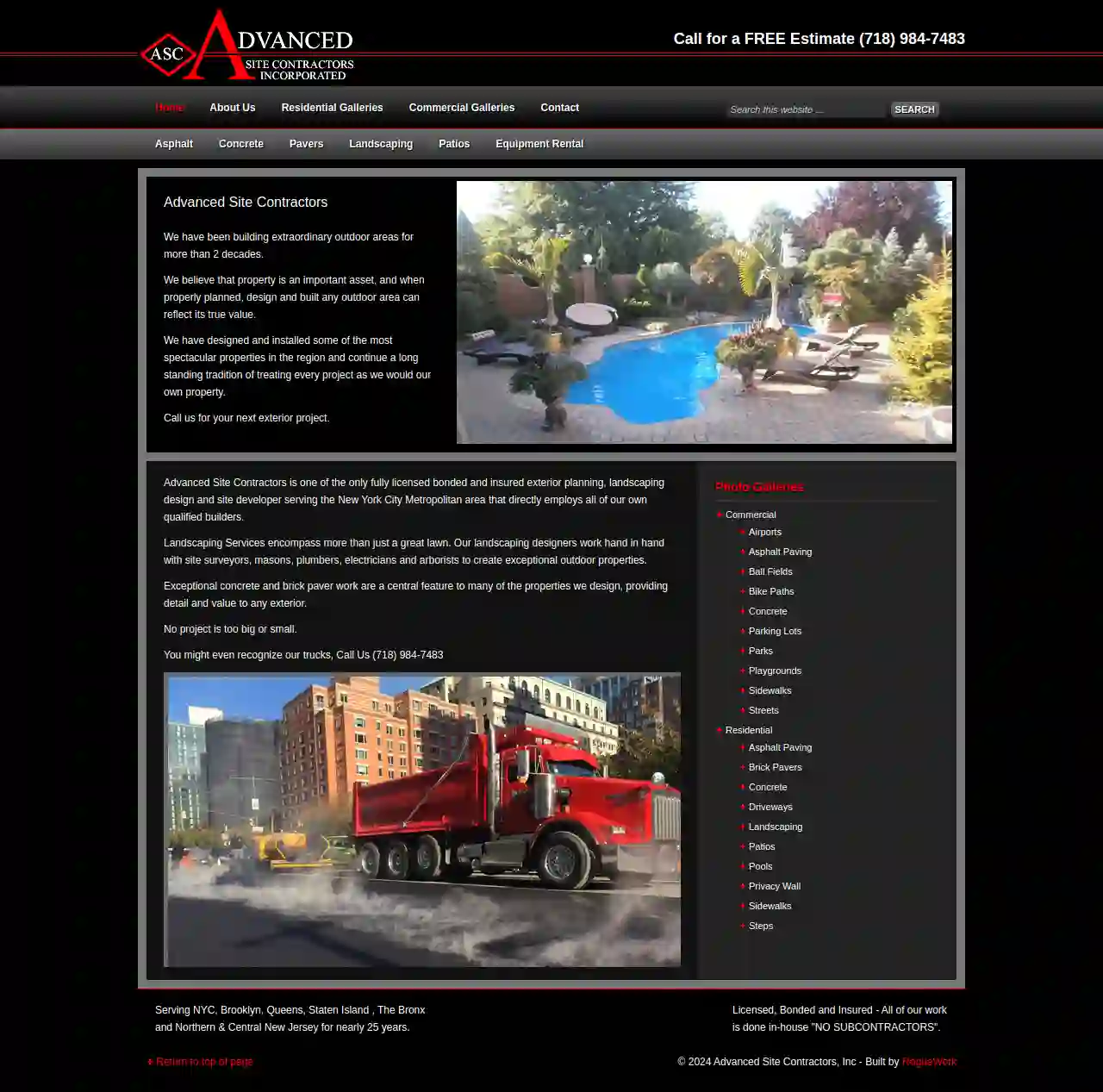Excavation Contractors Mountain Top
Best Excavation Services in Mountain Top
Receive multiple Excavation Company Near Me quotes for your project today! Compare profiles, reviews, accreditations, portfolio, etc... and choose the best service.

Stag Excavation Construction & Supply
52 reviewsHamlin, USStag Excavation & Stone Yard Stag Excavation & Stone Yard is a family-owned and operated business serving the Hamlin, PA area. We offer a wide range of services, from excavating and demolition to hardscaping and custom home construction. We are committed to providing our clients with high-quality workmanship and exceptional customer service. Our team of experienced professionals is dedicated to exceeding your expectations and delivering projects on time and within budget. We are proud to be a trusted name in the community and look forward to serving your needs. We are located just outside of Hamlin Corners in Hamlin PA. We offer free estimates on all of our services. Contact us today to schedule a consultation.
- Services
- Why Us?
- Testimonials
- Gallery
Get Quote
Big Horn Excavating LLC
Lykens, PA, 17048, USExcavation Company It doesn’t matter whether an excavation job is straightforward or complex, every project could benefit from professionalism—and that is why so many people look to Big Horn Excavating LLC when they are in need. Offering exceptional excavation services, we are the contractors that set big projects in motion. We work alongside landscapers, homeowners, and general contractors on a regular basis. So whether you are looking for someone to prepare a site for basement construction or dredge silt and muck from a community pond, we are the ones you can count on. Skilled in All Excavation Services We pride ourselves on our versatile nature. Our contractors might find themselves offering services to aid in installing a stormwater drain one day, only to be excavating earth and topsoil for a backyard pond the next day. Some of the additional excavation services we offer include: Earth moving Grading Rock removal Basement excavation Site preparation services And more With so many services at your disposal, you will never have to look to another excavation team ever again. Reach out to us today to learn more about the services we offer. All the Excavation Equipment Needed Every excavation project is different. Thankfully, we are always prepared for whatever obstacle comes our way. Between our years of experience and vast storehouse of equipment, our accredited team always rises to the occasion. We move mountains for our clients—along with topsoil, earth, rock, and debris. When your upcoming project calls for an excavator, look to us. Serving the Entire Community We deliver grading and excavation solutions for industries and individuals of all distinctions. Some of the professionals we commonly work with include: Real estate developers Municipal construction operations Engineers Architecture firms General contractors Utility companies Our versatile nature allows us to envision the entire scope of our client’s construction projects. In doing so, we lay the best foundation possible for all the work to come. If you would like to learn more about our services, please feel free to contact our offices at your convenience. Excavation and Excellent Customer Service When it comes to your construction projects, you only want professionals on site. Rest assured, you will absolutely love our professional yet personable approach to excavation. We are always happy to answer your questions and address any concerns you might have.
- Services
- Why Us?
- Gallery
Get Quote
Mar's Excavating
3031 Bellview Rd., Schnecksville, 18078, USExcavation with Integrity Mar’s Excavating, a full-service excavating company established over 35 years ago, has been serving the Lehigh Valley and surrounding areas with exceptional excavation services. We are dedicated to providing environmentally friendly solutions for both residential and commercial clients, including home builders, commercial contractors, subcontractors, and septic tank system installers. Our commitment to quality and safety ensures that you receive excavation services that are second to none. Providing Reasonably Priced Services Our company was founded with the goal of bringing high-quality excavation services to the Lehigh Valley and surrounding areas. Our experienced team is dedicated to providing hands-on, accessible service for every project. We are committed to getting your job done right, on time, and within budget. Learn More About Our Services Fully licensed and insured in the state of Pennsylvania, we are known for our unwavering commitment to safety and quality. If you'd like to learn more about our excavation services, please don't hesitate to contact Mark today. You can reach us by phone or email for your convenience.
- Services
- Why Us?
- Our Team
- Gallery
Get Quote
Rock Solid Landscaping and Masonry Design, Inc
3.723 reviews516 Industrial Loop, Staten Island, 10309, USAward winning landscape design & build since 1998 Full Service Landscape Architects Award winning landscape design & build since 1998 Full Service Landscape Architects Award winning landscape design & build since 1998 Full Service Landscape Architects Rock Solid Landscape and Masonry Design Inc specializes in designing and creating your dream home. Being experts in both hardscape and landscape design in Staten Island, we will help build the concept from your vision and ideas, and bring them to life. From start to finish, we work together with each of our clients to ensure that the work that is being done matches the concept that they dreamed up. Let Rock Solid Landscape and Masonry Design Inc create your next landscape masterpiece. Rock Solid Yards is the winner of Two 2010 Staten Island Chamber of Commerce Building Awards for: ROCK SOLID LANDSCAPE AND MASONRY DESIGN INC. more about us Serving the Tri-State area since 1998. MICHAEL IZZO OWNER/MASTER DESIGNER Michael Izzo has over 20 years of Landscape and Masonry Construction experience. He built Rock Solid Landscape and Masonry Design, Inc. from the ground up and he attributes his success to practicing good old fashioned business ethics and promoting a company philosophy of “exceeding customer expectations”. “Customers will return to and promote a business that consistently shows up and delivers exceptional quality projects on schedule and on budget. It’s really that simple.” Trust us for your masonry design and landscaping in Staten Island
- Services
- Why Us?
- Our Team
- Testimonials
- Gallery
Get Quote
CAG Construction Corp.
30 Summit Ave., Staten Island, 10306, USCAG Construction: Your Trusted Partner for Concrete Construction and Site Work CAG Construction is a family-run business established in 2007, specializing in all phases of concrete construction and site work. We are committed to delivering projects within budget, on time, and with the utmost professionalism. Our team has the experience and expertise to work seamlessly with project managers and design teams, ensuring a smooth construction process. Our Commitment to Excellence Edward Gonzalez, our founder, is a graduate of the NYC Small Business Services Construction Mentorship Program, NYC SBS Bond Readiness Program, and the New York City Economic Development Corporation – Construct NYC Program. This comprehensive training has equipped us with the knowledge and skills to deliver exceptional results. Certifications and Accreditations We are proud to be a New York City MBE Certified company, demonstrating our commitment to diversity and inclusion. We are also SCA Approved and a member of the National Association of Minority Contractors (NAMC), further solidifying our dedication to industry standards and ethical practices.
- Services
- Why Us?
- Gallery
Get Quote
Capitol View Excavating & Paving
350 Poplar Church Road, Camp Hill, PA, 350 Poplar Church Road Camp Hill, 7172262179, USAbout Us My name is Neil McCoy and I lead the team at Capitol View Excavating and Paving. I was born and raised in Carlisle, and I have worked here my entire life. My team and I understand central Pennsylvania is a small community, and every client and every job is important to us. We will listen well and then do the best job we can every time. If you need sitework, paving or any related services, we are excited about working with you. Results-Driven Approach We are not just a construction company; we are results-driven. Our commitment to excellence is evident in the successful completion of every project. Capitol View Excavating & Paving ensures that your project is delivered on time, within budget, and with the quality that exceeds expectations. Our core values are: Reliable Ethical Skilled Understanding Local Trusted Team Successful Experienced Team Our team brings a wealth of experience to every project. From skilled asphalt contractors to expert concrete craftsmen, Capitol View Excavating & Paving boasts a team of professionals dedicated to delivering top-tier construction services. Client Satisfaction Your satisfaction is our priority. We believe in transparent communication and working closely with our clients to understand their unique needs. Capitol View Excavating & Paving provides personalized solutions that not only meet but exceed expectations. We Have Answers Select Capitol View Excavating & Paving as your preferred construction partner for all your needs in Pennsylvania. Our dedication to achieving outstanding RESULTS distinguishes us as a reliable choice in the construction industry. Reach out to us today to schedule a consultation and discover the impact of collaborating with a construction company that prioritizes delivering tangible results.
- Services
- Why Us?
- Our Team
- Gallery
Get Quote
David H. Martin Excavating, Inc.
4.350 reviews4961 Cumberland Highway, Chambersburg, 17202, USYour Complete Excavating Solution Your projects deserve a reliable partner in delivering highly trained and trusted excavation solutions for jobs of any size. Our highly trained team is equipped with the skills and capabilities designed for residential homeowners to commercial project managers. Excellence & Integrity We understand the frustrations that arise with extended project completion dates, unexpected costs, and uncommunicative teams. Excellence and integrity are at the core of everything we do—it’s not just what we do, but the foundation for all that we are. Expect your project to be completed and on time—everytime.
- Services
- Why Us?
- Our Team
- Testimonials
Get Quote
Central Penn. Excavating llc
51 reviewsHarrisburg, USYour Trusted Partner in Excavation and Site Preparation At Central Penn Excavating, we specialize in delivering top-quality excavation, land clearing, tree removal, hardscaping, and concrete services across Pennsylvania. Whether you're preparing a site for construction, enhancing your landscape, or removing hazardous trees, our experienced team is here to ensure your project is completed with precision, safety, and excellence. Let us lay the groundwork for your success with reliable, professional service you can count on. Our Story: Building Strong Foundations for Pennsylvania Central Penn Excavating was founded with a commitment to delivering exceptional service and quality in every project we undertake. As a locally owned and operated company, we pride ourselves on our deep roots in the Pennsylvania community and our dedication to helping our neighbors achieve their goals. From humble beginnings, we have grown into a trusted name in excavation, land clearing, and site preparation, known for our reliability, professionalism, and attention to detail.
- Services
- Why Us?
- Gallery
Get Quote
Dillsburg Excavating & Septic, Inc.
441 reviews516 Range End Rd, Dillsburg, 17019, USDillsburg’s Excavation & Septic Experts Since 1957 Since 1957, Dillsburg Excavating & Septic, Inc. has been serving clients’ excavation and septic needs in Dillsburg, Pennsylvania, and the surrounding areas, including all of York, Adams, Cumberland, Dauphin, and Perry Counties. Our crew can handle all types and sizes of commercial and residential projects. We can also clean your clogged drain or fix your septic system with our sister company, Drain & Pump Services. Comprehensive excavation and septic systems are our areas of expertise. With our extensive experience—more than 65 years—you can rely on our team to provide top-notch services at competitive rates. We use the most recent tools and cleaning techniques to guarantee that all our services are completed on time.Ready to get started? Dillsburg Excavating & Septic, Inc. always offers a free estimate, and we also offer military discounts! Give us a call or reach out today! We can’t wait to meet you and see how we can help!
- Services
- Why Us?
- Gallery
Get Quote
Advanced Site Contractors
4.714 reviewsYork, USAdvanced Site Contractors We have been building extraordinary outdoor areas for more than 2 decades. We believe that property is an important asset, and when properly planned, design and built any outdoor area can reflect its true value. We have designed and installed some of the most spectacular properties in the region and continue a long standing tradition of treating every project as we would our own property. Call us for your next exterior project. Advanced Site Contractors is one of the only fully licensed bonded and insured exterior planning, landscaping design and site developer serving the New York City Metropolitan area that directly employs all of our own qualified builders. Landscaping Services encompass more than just a great lawn. Our landscaping designers work hand in hand with site surveyors, masons, plumbers, electricians and arborists to create exceptional outdoor properties. Exceptional concrete and brick paver work are a central feature to many of the properties we design, providing detail and value to any exterior. No project is too big or small. You might even recognize our trucks, Call Us (718) 984-7483
- Services
- Why Us?
- Gallery
Get Quote
Over 22,076+ Excavation Businesses on our platform
Our excavation providers operate in Mountain Top & beyond!
ExcavationHQ has curated and vetted Top Excavation Contractors near Mountain Top. Find the most reliable business today.
Frequently Asked Questions About Excavation Contractors
- Topsoil Removal: Stripping the fertile topsoil layer from a site, often preserving it for landscaping.
- Trench Excavation: Digging long, narrow trenches for utilities (pipes, cables) or foundations.
- Basement Excavation: Removing earth to create a space for a basement beneath a structure.
- Pool Excavation: Digging a precise hole for installing a swimming pool.
- Roadway Excavation: Removing earth and preparing the ground for road construction.
- Demolition Excavation: Clearing debris and preparing the site after demolition.
- Channel Excavation: Creating channels for drainage or irrigation.
- Project Type and Size: Ensure the contractor has experience handling projects similar to yours in scale and complexity.
- Reputation and Reviews: Check online reviews and testimonials, and request references from previous clients.
- Licensing and Insurance: Verify that the contractor is properly licensed and insured to protect you from liability.
- Equipment and Resources: Confirm that they have the necessary equipment and resources for your project's needs.
- Communication and Transparency: Choose a contractor who communicates clearly, provides detailed estimates, and keeps you informed throughout the project.
- Safety Record: Inquire about their safety protocols and track record to ensure a safe work environment.
- Price: While price is important, it shouldn't be the only deciding factor. Balance affordability with experience, reputation, and quality of service.
- Determining Soil Suitability: Assessing whether the soil can support the intended structure or load.
- Recommending Foundation Types: Advising on the appropriate foundation design based on soil characteristics.
- Addressing Drainage and Erosion Issues: Providing solutions to manage water runoff and prevent erosion.
- Evaluating Slope Stability: Assessing the risk of landslides or soil movement on slopes.
- Building on challenging soil types (expansive clay, loose sand, etc.)
- Constructing large or complex structures
- Excavating near slopes or retaining walls
- Addressing drainage or erosion concerns
- Determine the Area: Measure the length and width of the area you want to fill. Multiply them to get the area in square feet (or meters).
- Determine the Depth: Measure the difference between the existing grade and the desired grade (how much you need to raise the ground). This is the depth of fill required.
- Calculate Volume: Multiply the area (step 1) by the depth (step 2) to get the volume in cubic feet (or meters).
- Account for Compaction: Fill dirt compacts when it settles, so add 10% to 25% to the calculated volume to account for compaction. The exact percentage depends on the type of fill material.
What are the different types of excavation?
How do I choose the right excavation contractor for my project?
What is a soil engineer, and do I need one?
How do I calculate how much dirt I need for fill?
What are the different types of excavation?
- Topsoil Removal: Stripping the fertile topsoil layer from a site, often preserving it for landscaping.
- Trench Excavation: Digging long, narrow trenches for utilities (pipes, cables) or foundations.
- Basement Excavation: Removing earth to create a space for a basement beneath a structure.
- Pool Excavation: Digging a precise hole for installing a swimming pool.
- Roadway Excavation: Removing earth and preparing the ground for road construction.
- Demolition Excavation: Clearing debris and preparing the site after demolition.
- Channel Excavation: Creating channels for drainage or irrigation.
How do I choose the right excavation contractor for my project?
- Project Type and Size: Ensure the contractor has experience handling projects similar to yours in scale and complexity.
- Reputation and Reviews: Check online reviews and testimonials, and request references from previous clients.
- Licensing and Insurance: Verify that the contractor is properly licensed and insured to protect you from liability.
- Equipment and Resources: Confirm that they have the necessary equipment and resources for your project's needs.
- Communication and Transparency: Choose a contractor who communicates clearly, provides detailed estimates, and keeps you informed throughout the project.
- Safety Record: Inquire about their safety protocols and track record to ensure a safe work environment.
- Price: While price is important, it shouldn't be the only deciding factor. Balance affordability with experience, reputation, and quality of service.
What is a soil engineer, and do I need one?
- Determining Soil Suitability: Assessing whether the soil can support the intended structure or load.
- Recommending Foundation Types: Advising on the appropriate foundation design based on soil characteristics.
- Addressing Drainage and Erosion Issues: Providing solutions to manage water runoff and prevent erosion.
- Evaluating Slope Stability: Assessing the risk of landslides or soil movement on slopes.
- Building on challenging soil types (expansive clay, loose sand, etc.)
- Constructing large or complex structures
- Excavating near slopes or retaining walls
- Addressing drainage or erosion concerns
How do I calculate how much dirt I need for fill?
- Determine the Area: Measure the length and width of the area you want to fill. Multiply them to get the area in square feet (or meters).
- Determine the Depth: Measure the difference between the existing grade and the desired grade (how much you need to raise the ground). This is the depth of fill required.
- Calculate Volume: Multiply the area (step 1) by the depth (step 2) to get the volume in cubic feet (or meters).
- Account for Compaction: Fill dirt compacts when it settles, so add 10% to 25% to the calculated volume to account for compaction. The exact percentage depends on the type of fill material.